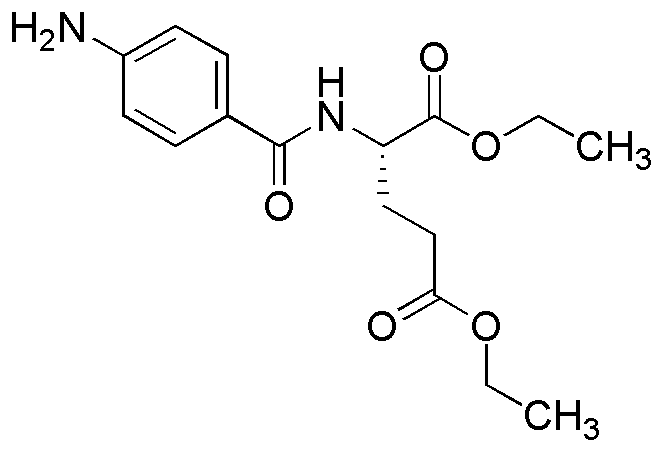N-(4-Aminobenzoyl)-L-glutamic acid diethyl ester is widely utilized in research focused on:
- Pharmaceutical Development: This compound serves as a key intermediate in the synthesis of various pharmaceuticals, particularly in the development of drugs targeting neurological disorders.
- Bioconjugation: It is used in bioconjugation processes to link biomolecules, enhancing the delivery and efficacy of therapeutic agents in targeted drug delivery systems.
- Research in Cancer Therapy: The compound plays a role in cancer research, particularly in developing targeted therapies that utilize its properties to inhibit tumor growth.
- Analytical Chemistry: It is employed as a reagent in analytical methods to detect and quantify amino acids and peptides, providing valuable insights in biochemical research.
- Food Industry Applications: The compound can be used in food science for the development of flavor enhancers and preservatives, improving food quality and shelf-life.
General Information
Properties
Safety and Regulations
Applications
N-(4-Aminobenzoyl)-L-glutamic acid diethyl ester is widely utilized in research focused on:
- Pharmaceutical Development: This compound serves as a key intermediate in the synthesis of various pharmaceuticals, particularly in the development of drugs targeting neurological disorders.
- Bioconjugation: It is used in bioconjugation processes to link biomolecules, enhancing the delivery and efficacy of therapeutic agents in targeted drug delivery systems.
- Research in Cancer Therapy: The compound plays a role in cancer research, particularly in developing targeted therapies that utilize its properties to inhibit tumor growth.
- Analytical Chemistry: It is employed as a reagent in analytical methods to detect and quantify amino acids and peptides, providing valuable insights in biochemical research.
- Food Industry Applications: The compound can be used in food science for the development of flavor enhancers and preservatives, improving food quality and shelf-life.
Documents
Safety Data Sheets (SDS)
The SDS provides comprehensive safety information on handling, storage, and disposal of the product.
Product Specification (PS)
The PS provides a comprehensive breakdown of the product’s properties, including chemical composition, physical state, purity, and storage requirements. It also details acceptable quality ranges and the product's intended applications.
Certificates of Analysis (COA)
Search for Certificates of Analysis (COA) by entering the products Lot Number. Lot and Batch Numbers can be found on a product’s label following the words ‘Lot’ or ‘Batch’.
Numéro de catalogue
Numéro de lot/série
Certificates Of Origin (COO)
This COO confirms the country where the product was manufactured, and also details the materials and components used in it and whether it is derived from natural, synthetic, or other specific sources. This certificate may be required for customs, trade, and regulatory compliance.
Numéro de catalogue
Numéro de lot/série
Safety Data Sheets (SDS)
The SDS provides comprehensive safety information on handling, storage, and disposal of the product.
DownloadProduct Specification (PS)
The PS provides a comprehensive breakdown of the product’s properties, including chemical composition, physical state, purity, and storage requirements. It also details acceptable quality ranges and the product's intended applications.
DownloadCertificates of Analysis (COA)
Search for Certificates of Analysis (COA) by entering the products Lot Number. Lot and Batch Numbers can be found on a product’s label following the words ‘Lot’ or ‘Batch’.
Numéro de catalogue
Numéro de lot/série
Certificates Of Origin (COO)
This COO confirms the country where the product was manufactured, and also details the materials and components used in it and whether it is derived from natural, synthetic, or other specific sources. This certificate may be required for customs, trade, and regulatory compliance.


